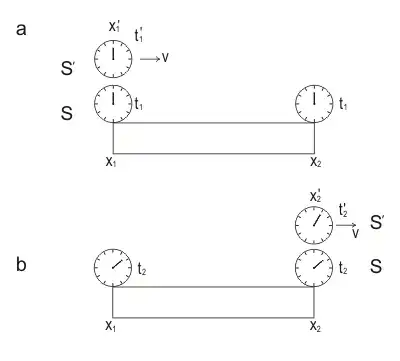You try to compare clock A with clock B, it is senseless.
The trick of Special Relativity is that you don't stay within one once chosen frame, but change frames. Each and every observer has his own "personal" frame of reference and thinks that he is "at rest". One frame is not enough and nobody confesses that he can move.
So, it makes no sense to say, that A moves relatively to B or vice versa. It is correct to say, that A moves in the reference frame of B and vice versa.
Reference frame is a lattice of synchronized clocks. Each "stationary" observer attaches to himself this lattice of synchronized clocks to measure space and time coordinates of events.
It is very important to understand method of synchronization of these clocks. Special relativity fantasizes that one - way speed of light is isotropic in all frames and allows only method to synchronize clocks - Einstein synchronization. This synchronization keeps one - way speed of light isotropic.
It works like that: person flashes a flash and when light reaches certain clock, adjusts this clock, assuming that one - way speed of light is c in all directions.
However, there are others self - consistent synchronizations. Einstein synchronization is a special case of Reichenbach's synchronization. Reichenbach's synchronization allows anisotropic one way speed of light, while two - way speed of light is isotropic.
For example, according to Reichenbach, speed of light in one direction can be very close to c/2 and in the other infinitely large, so two - way speed will still be c.
So, the time dilation formula means:
Single clock $S$ ticks slower than all Einstein - synchronized clocks of reference frame of $S'$; that means that according to clock $S$, time in reference frame $S'$ flows $1/\sqrt {1-v^2/c^2}$ times faster.
Single clock $S'$ ticks slower than all Einstein - synchronized clocks of reference frame of $S$; that means that according to clock $S'$, time in reference frame $S$ flows $1/\sqrt {1-v^2/c^2}$ times faster.
That goes out straight from the Lorentz transformations. We can take only two Einstein - synchronized clocks of "resting" reference frame $S$ or $S'$.


We can demonstrate time dilation of the SR in the following experiment (Fig. 1). Moving with velocity $v$ clocks measure time $t'$. The clock passes past point $x_{1}$ at moment of time $t_{1}$ and passing past point $x_{2}$ at moment of time $t_{2}$.
At these moments, the positions of the hands of the moving clock and the corresponding fixed clock next to it are compared.
Let the arrows of moving clocks measure the time interval $\tau _ {0}$ during the movement from the point $x_ {1}$ to the point $x_ {2}$ and the hands of clocks 1 and 2, previously synchronized in the fixed or “rest” frame $S$, will measure the time interval $\tau$. This way,
$$\tau '=\tau _{0} =t'_{2} -t'_{1},$$
$$\tau =t_{2} -t_{1} \quad (1)$$
But according to the inverse Lorentz transformations we have
$$t_{2} -t_{1} ={(t'_{2} -t'_{1} )+{v\over c^{2} } (x'_{2} -x'_{1} )\over \sqrt{1-v^{2} /c^{2} } } \quad (2)$$
Substituting (1) into (2) and noting that the moving clock is always at the same point in the moving reference frame $S'$, that is,
$$x'_{1} =x'_{2} \quad (3)$$
We obtain
$$\tau ={\tau _{0} \over \sqrt{1-v^{2} /c^{2} } } ,\qquad (t_{0} =\tau ') \quad (4) $$
This formula means that the time interval measured by the fixed clocks is greater than the time interval measured by the single moving clock. This means that the moving clock lags behind the fixed ones, that is, it slows down.
So, from the “point of view" of the "moving" single clock $S'$, time in reference frame $S$ flows $\gamma$ times faster.
This way we can see, that if moving observer compares his clock readings successively with synchronized clocks of reference frame he moves in, he will see, that these clocks change readings $\gamma$ times faster.
The animation below vividly demonstrates change of frames and "reciprocal" time dilation:

However, critical analysis of relativistic Doppler shift formula shows, that "A is slower than B and B is slower than A" is hardly possible.
Let's turn to the celebrated A. Einstein’s work “On the Electrodynamics of Moving Bodies”, &7, Theory of Doppler Principle and Aberration:
http://hermes.ffn.ub.es/luisnavarro/nuevo_maletin/Einstein_1905_relativity.pdf
From the equation for $\omega$ it follows that if an observer is moving with velocity $v$ relatively to an infinitely distant source of light of frequency $\nu$, in such a way that the connecting line “source-observer” makes the angle $\phi$ with the velocity of the observer referred to a system of co-ordinates which is at rest relatively to the source of light, the frequency $\nu'$ of the light perceived by the observer is given by the equation
$$\nu'=\nu \frac {1-cos \phi \cdot v/c}{\sqrt {1-v^2/c^2}} \quad (5)$$
Mr. Einstein clearly speaks that an observer is moving with velocity $v$ and that "the velocity of the observer referred to a system of co-ordinates which is at rest relatively to the source of light"
It is clear, that at the moment when "the connecting line “source-observer” makes the angle $\pi/2$ with the velocity of the observer" the formula (5) reduces to:
$$\nu'=\frac {\nu}{\sqrt {1-v^2/c^2}} \quad(6)$$
This is Transverse Doppler effect in the frame of the source. According to Mr. Einstein, when moving observer is at points of closest approach to the source, he sees only contribution of time dilation into relativistic Doppler shift (his clock is running slower), so the clock "at rest" appears to him running $\gamma$ times faster.
That simply means, that "A is slower that B" (Einstein synchronization) and "B is faster than A" (Reichenbach synchronization) is self - consistent, if A is considered "moving" and B is "at rest"
Please find transverse Doppler Effect diagram below:

Some references:
https://en.wikipedia.org/wiki/Observer_(special_relativity)
https://en.wikipedia.org/wiki/One-way_speed_of_light
https://en.wikipedia.org/wiki/Einstein_synchronisation
Relativistic Doppler Effect in Feynman Lectures and Mathpages/
http://www.feynmanlectures.caltech.edu/I_34.html
https://www.mathpages.com/home/kmath587/kmath587.htm




